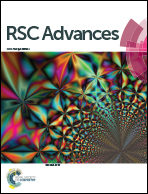What can electrospray mass spectrometry of paratungstates in an equilibrating mixture tell us?†
Abstract
An acidified aqueous solution of Na2WO4 at nearly neutral conditions, in which paratungstates A ([W7O24]6−) and B ([H2W12O42]10−) were coexistent in an equilibrating mixture, was firstly investigated by a combination of ESI-MS, 183W NMR and Raman spectroscopy. [W7O24]6− was proved to be the main species in the equilibrating mixtures at pH ≤ 7 by NMR and Raman spectroscopies, however, it failed to be detected by ESI-MS due to its limited stability in the gas phase. The distinctive composition of the precipitate from its precipitating solution suggests that the product isolated in its crystalline form may not necessarily be the one with the highest abundance in solution. This is the first representative example to demonstrate non-compliant structures derived from ESI-MS and NMR studies, illustrative of the limitation of ESI-MS analysis for labile POMs, and to show different speciation in the solid and its corresponding solution.


 Please wait while we load your content...
Please wait while we load your content...